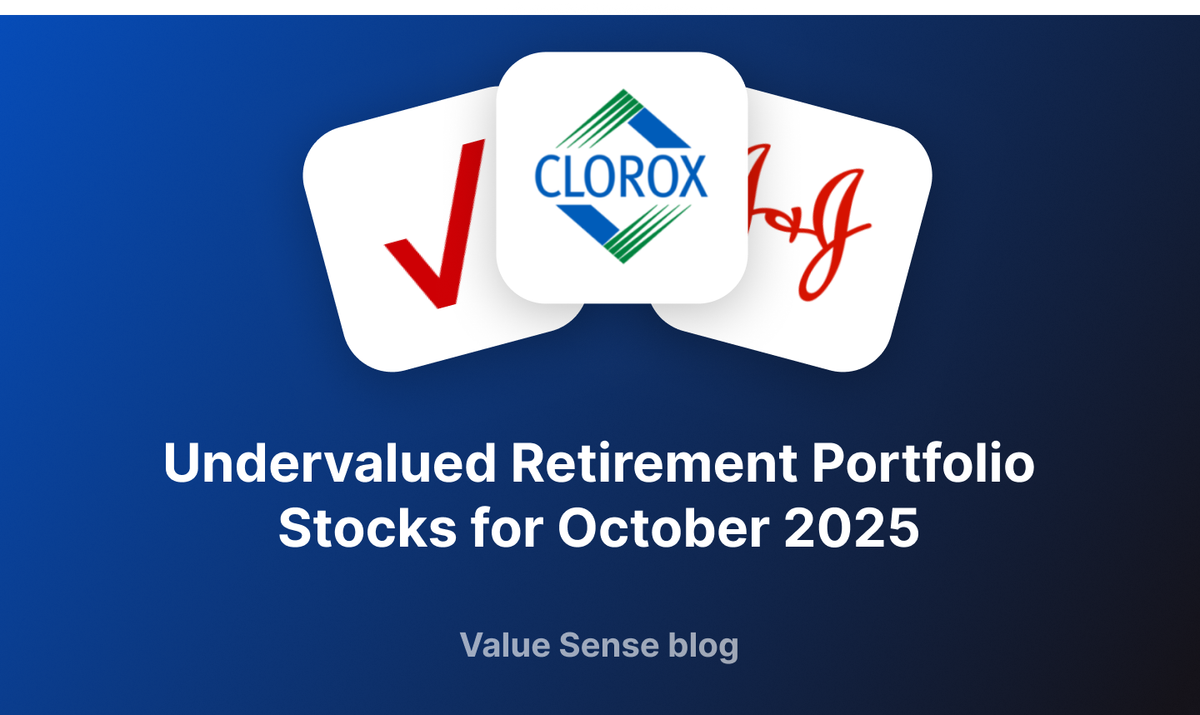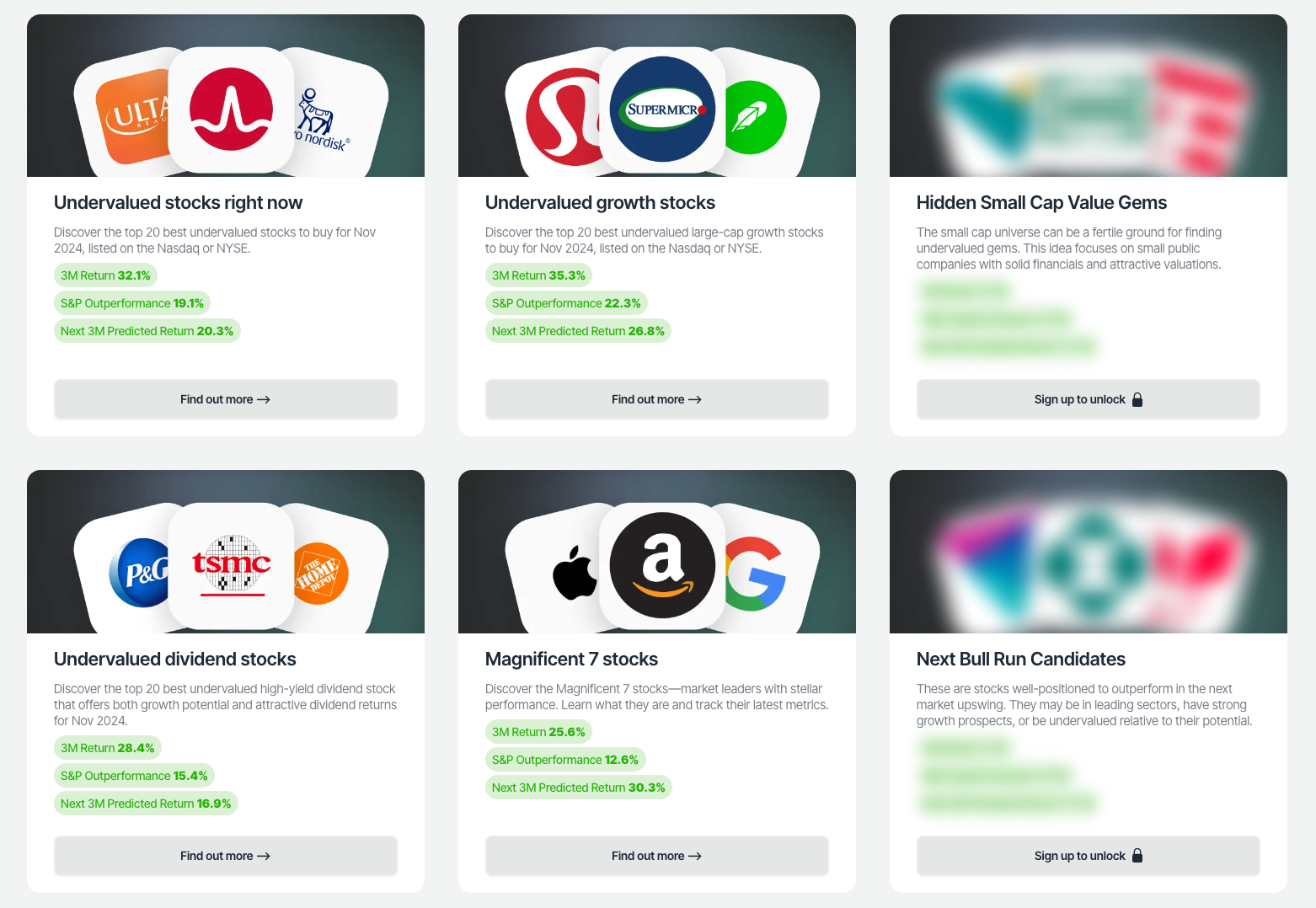Undervalued Retirement Portfolio Stocks for October 2025: Lifecycle Value

Welcome to the Value Sense Blog, your resource for insights on the stock market! At Value Sense, we focus on intrinsic value tools and offer stock ideas with undervalued companies. Dive into our research products and learn more about our unique approach at valuesense.io
Explore diverse stock ideas covering technology, healthcare, and commodities sectors. Our insights are crafted to help investors spot opportunities in undervalued growth stocks, enhancing potential returns. Visit us to see evaluations and in-depth market research.
Building a resilient, income-focused retirement portfolio means balancing safety, long-term growth, and value. As market volatility persists and many popular stocks remain expensive, October 2025 offers a window to accumulate undervalued retirement portfolio stocks—those combining strong fundamentals, attractive valuations, and reliability for every stage of the investing lifecycle. Below are some of the best value picks for retirement investors, blending blue-chip defensiveness, quality dividends, and sustainable upside.
What Makes a Stock Retirement-Ready and Undervalued?
Retirement investors look for companies with:
- Consistent revenue and profit growth
- Healthy dividend yields and payout stability
- Low to moderate leverage and strong cash flows
- Wide economic moats and sector resilience
- Attractive valuation metrics: low P/E, P/B, or high dividend discount
Undervalued stocks for retirement aren’t just “cheap”—they’re businesses with staying power that are out of favor or overlooked by the market, creating upside potential with downside protection.
Top Undervalued Retirement Portfolio Stocks (October 2025)
| Ticker | Company | Sector | Yield | P/E | Discount to Fair Value | Investment Highlights |
|---|---|---|---|---|---|---|
| CLX | Clorox | Consumer Staples | 3.9% | ~20 | 29% | Defensive moat, steady dividends, pricing power |
| BRK-B | Berkshire Hathaway | Conglomerate | N/A | ~21 | 5% | Diversification, low drawdown, capital allocation |
| VZ | Verizon | Telecom | 7.1% | 10.2 | 20%+ | High income, margin expansion as 5G scales |
| JNJ | Johnson & Johnson | Health Care | 3.3% | ~12 | 10% | Dividend king, pharma/consumer mix, strong FCF |
| EMN | Eastman Chemical | Materials | 4.0% | 9.8 | 15% | Cyclical upside, defensive balance sheet, FCF focus |
| ALL | Allstate | Financials | 2.5% | 9.6 | 18% | Defensive, asset-rich, capital returns |
| COST | Costco Wholesale | Consumer Staples | 1.0% | ~35 | 8% | Membership growth, stability, steady dividend hikes |
| CVS | CVS Health | Health Care | 3.5% | ~9 | 22% | Health services expansion, cheap vs. fair value |
| BG | Bunge Global | Agriculture | 3.1% | 8.2 | 18% | Commodity tailwinds, strong cost controls |
| DVN | Devon Energy | Energy | 4.2% | 8.0 | 28% | Free cash flow, disciplined capex, variable upside |
Data: valuesense.io
Stock-by-Stock Retirement Value Snapshots
Verizon Communications (VZ)
Verizon is a top pick for yield-oriented retirees, offering a resilient 6.1% dividend and trading near decade-low valuations (P/E ~10). The stock trades in the low $40s, about 20% below its historical average, yet operating cash flow remains robust and 5G monetization offers a gradually improving growth profile. For October 2025, analysts expect stabilization after prior declines, with price targets around $48 reflecting upside from current levels. Long-term, Verizon is expected to generate 2–3% annual revenue growth with rising margins as costly network upgrades taper. The reliable payout plus potential for a 25–35% total return (including dividend) over several years make VZ a strong retiree holding.
Eastman Chemical (EMN)
Eastman Chemical provides exposure to the materials sector at an attractive value. Despite Q2 2025 earnings and revenue misses (EPS $1.60, revenue $2.29B), the company stays committed to shareholder returns, maintaining a 4% dividend and ongoing share buybacks. The stock trades at a low P/E (under 10) and offers an estimated 20–30% discount to fair value based on future FCF and margin recovery. Eastman’s long-term thesis focuses on advanced recycling and sustainable materials, with a $78.82 fair value target signaling strong upside from recent lows, even as near-term performance reflects global trade uncertainties.
Clorox (CLX)
Clorox maintains its defensive consumer staple role, boasting nearly 4% yield and resilient sales even in tough years. Recent cost restructuring and margin recovery have driven net income and FCF growth, with protected pricing power across cleaning and household brands. Shares offer 15–25% upside to fair value with stable capital preservation for retirees.
Berkshire Hathaway (BRK-B)
Berkshire is a diversified fortress with a giant cash buffer ($320B), defensive businesses, and a proven capital allocation record. With a modest discount to intrinsic value and ultra-low drawdowns, it suits retirees who want both growth and risk management. Analysts forecast continued outperformance, steady buybacks, and low-teen CAGR returns.
Johnson & Johnson (JNJ)
JNJ is a dividend king with a 3.3%+ yield, payout ratio under 50%, and world-class pharma and MedTech businesses. In 2025, revenue and EPS both beat expectations, and an improved guidance for the year supports stable income and price appreciation.
Costco Wholesale (COST)
Costco combines income growth and total return, with a 1% yield but frequent special dividends and superior capital efficiency. The stock trades slightly below analyst fair value and is celebrated for its membership model, pricing power, and robust free cash flow—all key for retirement defensiveness.
CVS Health (CVS)
CVS is a healthcare conglomerate yielding 3.5% and trading at a depressed P/E of about 9. Vertical integration of pharmacies, clinics, and insurance creates steady recurring revenue—and the shares offer over 20% upside to analyst fair value as operating margins rebound and debt is reduced.
Bunge Global (BG)
Bunge offers retirees a value play on global agriculture, with a solid 3%+ dividend and high single-digit earnings yield. Commodity tailwinds, operational streamlining, and asset-light expansion underpin a fair value more than 15% above current trading levels.
Devon Energy (DVN)
Devon is favored for its 4.2% dividend, FCF discipline, and shareholder-friendly capital return policies. With oil prices supported and a payout that flexes with commodity cycles, DVN trades well below intrinsic value—ideal as a yield and inflation-hedge anchor for retirement portfolios.
How to Build a Lifecycle Value Retirement Portfolio
- Diversify across sectors: Core holdings in staples, health, telecom, energy, and insurance reduce drawdowns.
- Mix yield with growth: Select higher yielders for income (VZ, EMN) and “growers” like COST or CVS for capital appreciation.
- Focus on intrinsic value: Choose stocks trading at meaningful discounts to their fair value estimates and with analyst support.
- Review each year: As interest rates and valuations shift, rebalance toward the most undervalued and resilient names.
Explore More Investment Opportunities

For investors seeking undervalued companies with high fundamental quality, our analytics team provides curated stock lists:
📌 50 Undervalued Stocks (Best overall value plays for 2025)
📌 50 Undervalued Dividend Stocks (For income-focused investors)
📌 50 Undervalued Growth Stocks (High-growth potential with strong fundamentals)
🔍 Check out these stocks on the Value Sense platform for free!
More Articles You Might Like
📖 Visa Stock Analysis: Undervalued Digital Payments Growth Story
📖 Fortress Balance Sheets: The Best Low-Debt Companies
📖 High ROIC Stocks in September 2025: The Best Quality Compounders
📖 Adobe Stock Analysis: Undervalued Creative Software Monopoly
📖 Pfizer Undervalued Post-COVID
FAQ
Q: Why include undervalued stocks in a retirement portfolio now?
A: Buying at a discount offers downside protection, higher future returns, and steadier income streams—essential as markets face late-cycle risks.
Q: Do all these stocks pay dividends?
A: Nearly all, with some (BRK-B, COST) preferring buybacks or alternative capital returns for compounding.
Q: Is it better to focus on high yield or growth for retirement?
A: A mix is optimal. Some stocks provide immediate income, others (like Costco) offer inflation-beating dividend growth and capital appreciation.
Q: How often should a retirement investor review their portfolio?
A: At least annually, or after major market shifts, to lock in gains and rotate into newly undervalued quality names.
